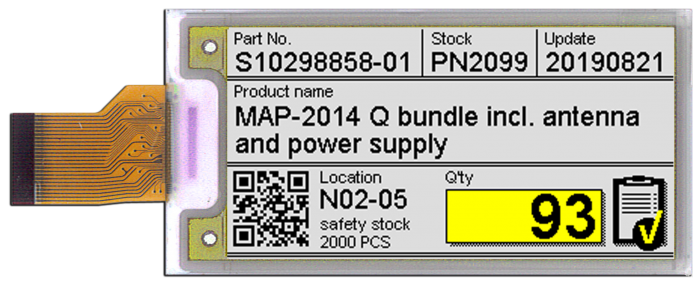Speeding up stock-picking in warehouses: Blending e-paper, RFID and energy harvesting
10 Oct 2019

Low energy usage and eye-catching colors mean e-paper displays offer a cost-effective way to help pickers hone in faster on the right stock.
By Scott Soong, CEO, Pervasive Displays
In logistics, speed is everything. Whether it’s to get an ecommerce order to a customer who’s paid for next- or even same-day delivery, or to get critical parts to a manufacturer last-minute, finding and picking stock quickly is essential.
One of the challenges, as identified by Logistics Management’s recent survey on warehouses and distribution centers, is that 79% of these facilities depend on temporary staff during peak periods. Of course, these individuals are necessarily less familiar with where things are in the warehouse, meaning they won’t be able to work as quickly as permanent staff. And even though facility operators want to automate more, a third of respondents still indicated a need to increase staffing numbers.
So how can warehouse owners help their workers – and particularly temporary ones – find exactly where things are more quickly?
Supporting the final honing-in by complementing RFID and positioning technologies
Two technologies are already being used to guide employees towards the stock they’re required to pick. RFID is one. It helps with stock-management by recording levels and the location of stock in real time. It also provides the flexibility to store things in different locations, while still being able to direct workers to the right places.
The second is an adaptation of global navigation satellite system (GNSS) positioning. This tracks where the picker is and directs them to where the stock is located, sometimes with accuracy to the nearest meter. But once they get there, they still need to find exactly where the required item is.
A visual cue on a shelf-mounted display could speed up this critical part of the process. These displays could be updated wirelessly using RFID data, transmitted from the picker’s handheld device or a wearable wireless ID tag. There could even be multiple displays used to guide the person to the precise location: firstly at eye height when they get to the right section of shelving (the x-axis, if you will), then a second when they reach the correct shelf (the y-axis).
The energy challenge
Of course, displays require energy. This could be delivered through mains wiring, though this would be expensive to fit and limit the ability to move displays around. Another option is to use a battery, which would mean the display can be relocated as needed. Batteries, of course, eventually run out, so any display technology would have to be exceptionally energy-efficient. Otherwise, the cost and effort required to regularly change the batteries in hundreds or thousands of displays in a single warehouse would be unsustainable.
The third approach is to harvest RF energy, using the ISO 18000-6c standard. This has been shown to work from several meters away, which would be ideal for the warehouse use case. The picker is guided to the approximate location using the technologies described above, at which point displays in the relevant places come on to guide the final part of their journey. However, the amount of energy available in this scenario is severely limited. And this means a traditional TFT LCD is out of the question: its energy requirements would simply be too high.
Why e-paper is the ideal solution to accelerate stock-picking in warehouses
E-paper displays, on the other hand, draw very small amounts of current to update their contents – around 10% of what a TFT LCD demands. And crucially, with e-paper, once an image is visible, no further energy is needed to keep it there. (A TFT LCD, on the other hand, has to refresh up to 50 times per second just to maintain a static image.) This means e-paper displays are a realistic option in devices running off small batteries or harvested energy.
E-paper is also easy to read, because of the way it uses physical e-ink particles to build up an image. These reflect ambient light, in precisely the same way that printed words on paper do. As a result, the display contents can be read even in bright sunlight or harsh lighting conditions, and a power-hungry backlight isn’t required. Viewing angles are close to 180°.
Thirdly – and importantly for our warehouse use case – latest-gen e-paper can display red or yellow, as well as black and white. These eye-catching colors could be used to draw pickers’ eyes to the right places quickly.
A ready-to-go solution
E-paper made its name in e-book readers, and is now spreading into other areas, from parking meters to medicine. We can manufacture our color-capable e-paper displays (available from 1.54 to 12.2-inch) in high volumes so they are the perfect choice for logistics businesses who are looking for a cost-effective way to speed up their stock-picking processes.
Category: Blog
Back to News